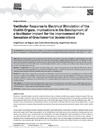Identificador persistente para citar o vincular este elemento:
https://accedacris.ulpgc.es/jspui/handle/10553/35447
| Campo DC | Valor | idioma |
|---|---|---|
| dc.contributor.author | Ramos de Miguel, Ángel | en_US |
| dc.contributor.author | Falcon Gonzalez, Juan Carlos | en_US |
| dc.contributor.author | Ramos Macías, Ángel | en_US |
| dc.date.accessioned | 2018-04-19T08:57:21Z | - |
| dc.date.available | 2018-04-19T08:57:21Z | - |
| dc.date.issued | 2017 | en_US |
| dc.identifier.issn | 1308-7649 | en_US |
| dc.identifier.uri | https://accedacris.ulpgc.es/handle/10553/35447 | - |
| dc.description.abstract | OBJECTIVE: Electrical stimulation of the utricular and saccular portions of the vestibular nerve improves stability in patients suffering from vestibular dysfunction. The main objective of this study was to evaluate a new technique, vestibular response telemetry (VRT), for measuring the electrically evoked vestibular compound action potential (saccular and utricular) after stimulating the otolith organ (saccular and utricular) in adults. This study used evidence that the otolith organ can be electrically stimulated in order to develop a new vestibular implant design to improve the sensation of gravitoinertial acceleration. MATERIALS and METHODS: Four adult patients were evaluated by using a variety of measurement procedures with novel VRT software. VRT values were obtained by stimulating with three full-band Nucleus CI24RE (ST) electrodes. Specific stimuli were used. Simultaneously, electrical ocular vestibular evoked myogenic potentials (eoVEMPs) were recorded in the contralateral side. RESULTS: Electrically evoked compound action potentials were obtained in 10 of the 12 electrodes tested, and eoVEMPs were recorded when VRT was present. In addition to the validation of this technique, a set of default clinical test parameters was established. The VRT response morphology consisted of a biphasic waveform with an initial negative peak (N1) followed by a positive peak (P1), and latencies were typically 400 mu s for N1 and 800 mu s for P1. The consequences for the development of a vestibular implant for the improvement of gravitoinertial acceleration sensation are also presented. CONCLUSION: The VRT measurement technique has been shown to be a useful tool to record neural response on the otolith organ, and thus it is a convenient tool to evaluate whether the implanted electrodes provide a neural response or not. This can be used for the early development of vestibular implants to improve gravitoinertial acceleration sensation. | en_US |
| dc.language | eng | en_US |
| dc.relation.ispartof | Journal of International Advanced Otology | en_US |
| dc.source | Journal of International Advanced Otology[ISSN 1308-7649],v. 13, p. 154-161 | en_US |
| dc.subject | 3314 Tecnología médica | en_US |
| dc.subject | 32 Ciencias médicas | en_US |
| dc.subject.other | Vestibular response telemetry | en_US |
| dc.subject.other | Electrical vestibular myogenic response | en_US |
| dc.subject.other | Vestibular implant | en_US |
| dc.title | Vestibular response to electrical stimulation of the otolith organs. Implications in the development of a vestibular implant for the improvement of the sensation of gravitoinertial accelerations | en_US |
| dc.type | info:eu-repo/semantics/Article | es |
| dc.type | info:eu-repo/semantics/Article | en_US |
| dc.type | Article | es |
| dc.identifier.doi | 10.5152/iao.2017.4216 | |
| dc.identifier.scopus | 85030755662 | |
| dc.identifier.isi | 000408247500002 | - |
| dc.contributor.authorscopusid | 56848284600 | |
| dc.contributor.authorscopusid | 36618690700 | |
| dc.contributor.authorscopusid | 6701550535 | |
| dc.identifier.eissn | 2148-3817 | - |
| dc.description.lastpage | 161 | - |
| dc.identifier.issue | 2 | - |
| dc.description.firstpage | 154 | - |
| dc.relation.volume | 13 | - |
| dc.investigacion | Ciencias de la Salud | en_US |
| dc.type2 | Artículo | en_US |
| dc.contributor.daisngid | 2433059 | |
| dc.contributor.daisngid | 3993927 | |
| dc.contributor.daisngid | 1190904 | |
| dc.contributor.wosstandard | WOS:de Miguel, AR | |
| dc.contributor.wosstandard | WOS:Gonzalez, JCF | |
| dc.contributor.wosstandard | WOS:Macias, AR | |
| dc.date.coverdate | Enero 2017 | |
| dc.identifier.ulpgc | Sí | es |
| dc.description.sjr | 0,355 | |
| dc.description.jcr | 0,758 | |
| dc.description.sjrq | Q3 | |
| dc.description.jcrq | Q4 | |
| dc.description.scie | SCIE | |
| item.fulltext | Con texto completo | - |
| item.grantfulltext | open | - |
| crisitem.author.dept | GIR SIANI: Modelización y Simulación Computacional | - |
| crisitem.author.dept | IU Sistemas Inteligentes y Aplicaciones Numéricas | - |
| crisitem.author.dept | GIR SIANI: Ingeniería biomédica aplicada a estimulación neural y sensorial | - |
| crisitem.author.dept | IU Sistemas Inteligentes y Aplicaciones Numéricas | - |
| crisitem.author.dept | GIR SIANI: Ingeniería biomédica aplicada a estimulación neural y sensorial | - |
| crisitem.author.dept | IU Sistemas Inteligentes y Aplicaciones Numéricas | - |
| crisitem.author.dept | Departamento de Ciencias Médicas y Quirúrgicas | - |
| crisitem.author.orcid | 0000-0002-0528-815X | - |
| crisitem.author.orcid | 0000-0002-4709-5559 | - |
| crisitem.author.parentorg | IU Sistemas Inteligentes y Aplicaciones Numéricas | - |
| crisitem.author.parentorg | IU Sistemas Inteligentes y Aplicaciones Numéricas | - |
| crisitem.author.parentorg | IU Sistemas Inteligentes y Aplicaciones Numéricas | - |
| crisitem.author.fullName | Ramos De,Ángel | - |
| crisitem.author.fullName | Falcón González, Juan Carlos | - |
| crisitem.author.fullName | Ramos Macías, Ángel Manuel | - |
| Colección: | Artículos | |
Citas SCOPUSTM
25
actualizado el 08-jun-2025
Citas de WEB OF SCIENCETM
Citations
20
actualizado el 08-jun-2025
Visitas
224
actualizado el 20-abr-2024
Descargas
224
actualizado el 20-abr-2024
Google ScholarTM
Verifica
Altmetric
Comparte
Exporta metadatos
Los elementos en ULPGC accedaCRIS están protegidos por derechos de autor con todos los derechos reservados, a menos que se indique lo contrario.
